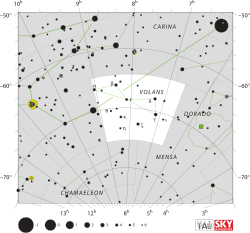Eta Volantis

| |
| Observation data Epoch J2000.0 Equinox J2000.0 | |
|---|---|
| Constellation | Volans |
| Right ascension | 08h 22m 04.45800s[1] |
| Declination | −73° 23′ 59.9525″[1] |
| Apparent magnitude (V) | 5.28[2] |
| Characteristics | |
| Spectral type | A0/1IV/V[3] |
| B−V color index | +0.01[2] |
| Astrometry | |
| Radial velocity (Rv) | +20[4] km/s |
| Proper motion (μ) | RA: −31.38[1] mas/yr Dec.: +29.73[1] mas/yr |
| Parallax (π) | 8.56 ± 0.16[1] mas |
| Distance | 381 ± 7 ly (117 ± 2 pc) |
| Absolute magnitude (MV) | 0.05[5] |
| Details | |
| Mass | 2.73±0.08[5] M☉ |
| Radius | 3.43[5] R☉ |
| Luminosity | 84[6] L☉ |
| Surface gravity (log g) | 3.81±0.04[5] cgs |
| Temperature | 8,663[6] K |
| Rotational velocity (v sin i) | 214[7] km/s |
| Age | 347[5] Myr |
| Other designations | |
Eta Volantis (η Vol, η Volantis) is a single star[9] in the southern constellation of Volans. It has an apparent visual magnitude of 5.28, which is bright enough to be seen with the naked eye. Based upon parallax measurements, it is approximately 381 light years from Earth.
This is a white A-type star with a blended spectrum that shows aspects of a main sequence star and a subgiant. It has two 12th magnitude optical companions at angular separations of 30.8 and 42.4 arcseconds.
References
- 1 2 3 4 5 van Leeuwen, F. (2007), "Validation of the new Hipparcos reduction", Astronomy and Astrophysics, 474 (2): 653–664, arXiv:0708.1752
 , Bibcode:2007A&A...474..653V, doi:10.1051/0004-6361:20078357.
, Bibcode:2007A&A...474..653V, doi:10.1051/0004-6361:20078357. - 1 2 Mermilliod, J.-C. (1986), "Compilation of Eggen's UBV data, transformed to UBV (unpublished)", Catalogue of Eggen's UBV data. SIMBAD, Bibcode:1986EgUBV........0M.
- ↑ Houk, Nancy (1978), Michigan catalogue of two-dimensional spectral types for the HD stars, 1, Ann Arbor: Dept. of Astronomy, University of Michigan, Bibcode:1975mcts.book.....H.
- ↑ Wilson, R. E. (1953), General Catalogue of Stellar Radial Velocities, Carnegie Institute of Washington, D.C., Bibcode:1953GCRV..C......0W.
- 1 2 3 4 5 Gerbaldi, M.; et al. (June 1999), "Search for reference A0 dwarf stars: Masses and luminosities revisited with HIPPARCOS parallaxes", Astronomy and Astrophysics Supplement, 137 (2): 273–292, Bibcode:1999A&AS..137..273G, doi:10.1051/aas:1999248.
- 1 2 McDonald, I.; Zijlstra, A. A.; Boyer, M. L. (2012). "Fundamental Parameters and Infrared Excesses of Hipparcos Stars". Monthly Notices of the Royal Astronomical Society. 427 (1): 343–57. arXiv:1208.2037
 . Bibcode:2012MNRAS.427..343M. doi:10.1111/j.1365-2966.2012.21873.x.
. Bibcode:2012MNRAS.427..343M. doi:10.1111/j.1365-2966.2012.21873.x. - ↑ Royer, F.; et al. (February 2007), "Rotational velocities of A-type stars. III. Velocity distributions", Astronomy and Astrophysics, 463 (2): 671–682, arXiv:astro-ph/0610785
 , Bibcode:2007A&A...463..671R, doi:10.1051/0004-6361:20065224.
, Bibcode:2007A&A...463..671R, doi:10.1051/0004-6361:20065224. - ↑ "eps Vol -- Spectroscopic binary", SIMBAD Astronomical Database, Centre de Données astronomiques de Strasbourg, retrieved 2016-09-02.
- ↑ Eggleton, P. P.; Tokovinin, A. A. (September 2008), "A catalogue of multiplicity among bright stellar systems", Monthly Notices of the Royal Astronomical Society, 389 (2): 869–879, arXiv:0806.2878
 , Bibcode:2008MNRAS.389..869E, doi:10.1111/j.1365-2966.2008.13596.x.
, Bibcode:2008MNRAS.389..869E, doi:10.1111/j.1365-2966.2008.13596.x.
This article is issued from Wikipedia - version of the 9/3/2016. The text is available under the Creative Commons Attribution/Share Alike but additional terms may apply for the media files.